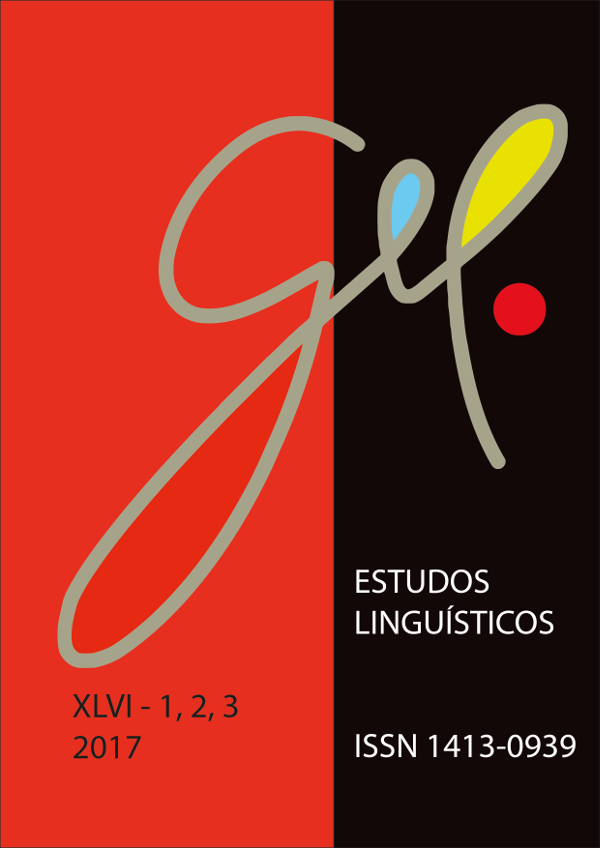Compreensão de ordem de palavras por crianças adquirindo o PB
DOI:
https://doi.org/10.21165/el.v46i2.1604Palavras-chave:
aquisição de L1, olhar preferencial, psicolinguísticaResumo
Este artigo apresenta os resultados de um experimento de Olhar Preferencial voltado ao estudo da compreensão de ordem de palavras por crianças adquirindo o Português Brasileiro (PB). O experimento consistiu em mostrar às crianças dois vídeos simultâneos, com dois personagens realizando uma ação transitiva, mas mudando o papel de agente e paciente entre os vídeos. Um estímulo auditivo narra apenas uma das cenas. Nossa hipótese de trabalho foi a de que as crianças olhariam por mais tempo para a cena correspondente ao estímulo auditivo, pois reconhecem as posições canônicas de agente e paciente nas sentenças e identificam estas posições nas cenas apresentadas. Os resultados, no entanto, nos levaram a concluir que a informação semântica é igualmente importante para a compreensão sentencial na faixa etária estudada, ao menos para o experimento apresentado.
Downloads
Referências
ARUNACHALAM, S.; ESCOVAR, E.; HANSEN, M. A.; WAXMAN, S. R. Out of sight, but not out of mind: 21-month-olds use syntactic information to learn verbs even in the absence of a corresponding event. Language and cognitive processes, v. 28,
p. 417-425, 2013.
CHOMSKY, N. A Review of B. F. Skinner's Verbal Behavior. Language, Washington, DC., v. 35, n. 1, p. 26-58, 1959.
_______. Knowledge of Language: Its Nature, Origin, and Use. New York: Praeger Publishers, 1986.
CHRISTOPHE, A.; MILLOTE, S.; BERNAL, S.; LIDZ, J. Bootstrapping lexical and syntactic acquisition. Language and speech, Thousand Oaks, CA., v. 51, n. 1, p. 61-75, 2008.
CRAIN, S.; MCKEE, C. Acquisition of Structural Restrictions on Anaphora. In: BERMAN, S.; CHOE, J.; MCDONOUGH, J. (Ed.). Proceedings of the XVI NELS, GSLA. University of Massachusetts, Amherst, 1986.
GERTNER, Y.; FISHER, C.; EISENGART, J. Learning words and rules: Abstract knowledge of word order in early sentence comprehension. Psychological Science, Thousand Oaks, CA., v. 17, p. 684-691, 2006.
GOLINKOFF, R. M.; WEIYI, M.; SONG, L.; HIRSH-PASEK, K. Twenty-Five Years Using the Intermodal Preferential Looking Paradigm to Study Language Acquisition: What Have We Learned? Perspectives on Psychological Science, Washington, DC.,
v. 8, n. 3, p. 316-339, 2013.
HALLÉ, P.; DURAND, C.; BOYSSON-BARDIES, B. Do 11-month-old French infants process articles? Language and Speech, Thousand Oaks, CA., v. 51, p. 23-44, 2008.
HIRSH-PASEK, K.; GOLINKOFF, R. M. The Origins of Grammar: evidence from early language comprehension. Massachusetts: The MIT Press, 1996.
KARMILOFF-SMITH, A. Micro and Macrodevelopmental Changes in Language Acquisition and Other Representational Systems. Cognitive science, v. 3, p. 91-118, 1979.
KLAHR, D. Non-monotone assessment of monotone development: An information processing analysis. In: STRAUSS, S.; STAVY, R. (Ed.). U-shaped behavioral growth. New York: Academic Press, 1982. p. 63-77.
KOLBERG, L. S. O processo de boostrapping na aquisição de linguagem. 2015. 176 f. Dissertação (Mestrado em Linguística) – Instituto de Estudos da Linguagem, Universidade Estadual de Campinas, Campinas, 2015.
LANDAU, B.; GLEITMAN, L. R. Language and experience: evidence from the blind child. Massachussets: Harvard University Press, 1985.
MACNAMARA, J. Names for things: A Study in Human Learning. Massachusetts: The MIT press, 1982.
MAZUKA, R. Can a grammatical parameter be set before the first word? Prosodic contributions to early setting of a grammatical parameter. In: MORGAN, J.; DEMUTH, K. (Ed.). Signal to syntax. Mahwah: Lawrence Erlbaum Associates, 1996. p. 313-330.
PINKER, S. Learnability and Cognition: The Acquisition of Argument Structure. Cambridge, MA: The MIT Press, 1989.
RESCORLA, L. Identifying expressive delay at age 2. Topics in Language Disorders, Philadelphia, v. 11, p. 14-20, 1991.
SILVA, M. L. Para uma taxonomia semântica de verbos do Português. GLÁUKS (Revista de Letras e Artes), Viçosa: UFV/DLA, v. 1, n. 1, p. 20-33, jul./dez. 1996.
STAGER, L. S.; WERKER, J. F. Infants listen for more phonetic detail in speech perception than in word learning tasks. Letters to Nature, London, v. 38, p. 381-382, 1997.
YUAN, S.; FISHER, C. “Really? He Blicked the Cat?”: Two-Year-Olds Learn Distributional Facts About Verbs in the Absence of a Referential Context. Proceedings of the 30th Annual Boston University Conference on Language Development. Boston: Cascadilla Press, 2006.



